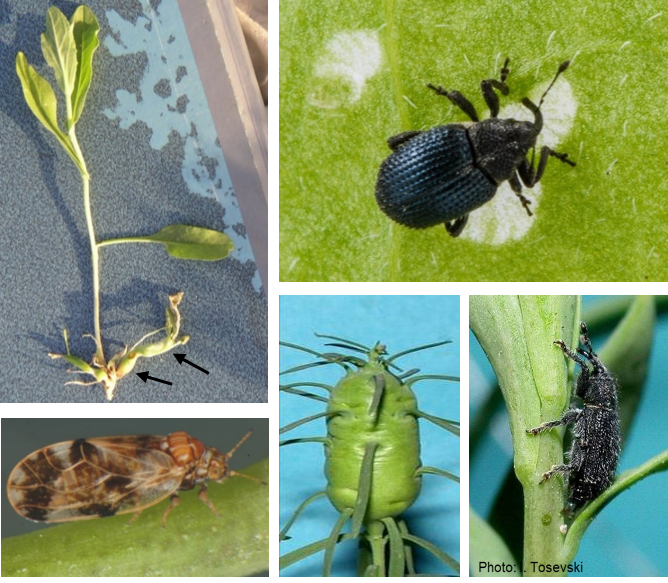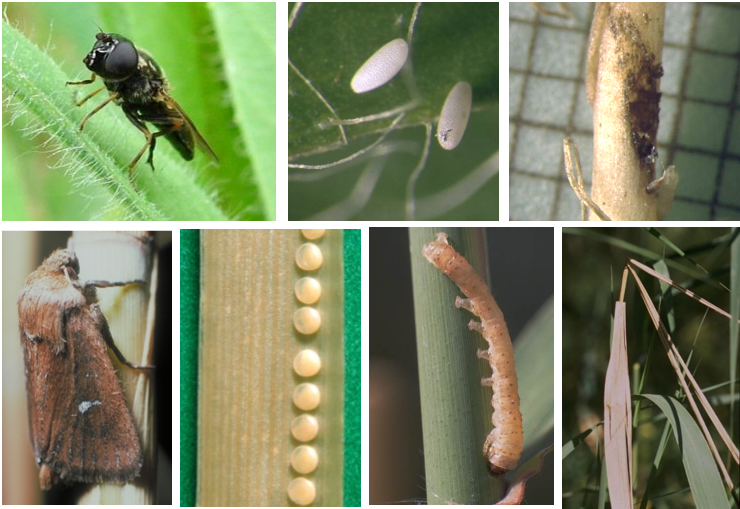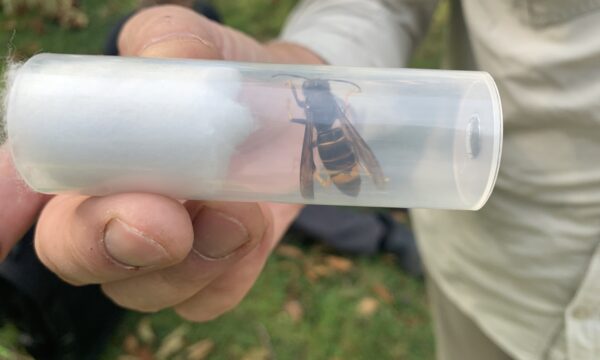
Like many countries, the USA suffers from the detrimental impacts of invasive weeds which can threaten livestock, crops, native species and sectors including agriculture and tourism.
In many of America’s Western states, invasive weeds such as houndstongue (Cynoglossum officinale), Russian knapweed (Rhaponticum repens), yellow and Dalmatian toadflax (Linaria vulgaris and Linaria dalmatica), oxeye daisy (Leucanthemum vulgare), and hoary cress (Lepidium draba) are serious problems. However, research shows that biological control, as part of an integrated weed management strategy, offers the potential for a cost effective and efficient way of reducing invasive plant species to levels below acceptable damage thresholds.
Most invasive weeds in North America are not native; they arrived with early settlers, through commerce, or by accident from different parts of the world. These non-native plants are generally introduced without their natural enemies, the complex of organisms that feed on the plants in their native range. The lack of natural enemies is one reason non-native plant species become invasive pests when introduced in areas outside of their native range. Biological control, or biocontrol, is the use of natural enemies such as insects, mites or fungal pathogens (referred to as biocontrol agents) to manage invasive pest populations.
A biocontrol agent is only proposed for field release in the invaded range after intensive research and rigorous testing to ensure its environmental safety. In the USA, weed biological control agents are regulated by the United States Department of Agriculture, Animal and Plant Health Inspection Service (USDA, APHIS). Petitions for field release are evaluated by a Technical Advisory Group (TAG), consisting of representatives of all concerned government agencies including the Fish and Wildlife Service.
APHIS requires that land managers have a permit to move weed biocontrol agents between states, reducing the opportunity for permitted weed biocontrol agents to cause unintended harm.
The last biocontrol agents to establish and to have a notable impact on their target weed in the western USA was in 2008 and 2009, with the release of a gall forming wasp, Aulacidea acroptilonica, and a gall midge, Jaapiella ivannikovi, for Russian knapweed control. Both species have successfully established, and a large distribution programme covering eight US states has been initiated. In Wyoming, the gall midge can reduce seed output by more than 90% and shoot biomass by 30%.
More recently, several biocontrol agents have been approved for release in the USA and there are a number of exciting biocontrol projects underway.
In 2019, the gall-forming weevil, Rhinusa pilosa, for the control of yellow toadflax and the eriophyid mite, Aceria drabae, for the control of hoary cress were released in Montana, and in spring 2020, three additional biocontrol agents followed: the gorse thrips, Sericothrips staphylinus, the yellow starthistle root-crown weevil, Ceratapion basicorne, and the invasive knotweed psyllid, Aphalara itadori. Next steps on these projects include confirming the establishment of the recently released agents, the further shipment of insects from the native range to quarantine facilities in the USA, the development of mass rearing methods and more widespread releases.
Three additional agents have been released in Canada, but not in the USA yet: the root-feeding hoverfly, Cheilosia urbana, for invasive hawkweed control, and two noctuid moths on common reed.
Whilst the majority of these agents have been researched by CABI scientists at CABI’s centre in Switzerland, three of the agents were investigated by other organizations: the aceria mite on hoary cress was studied by Jeff Littlefield (Montana State University), the root-crown weevil on yellow starthistle by Lincoln Smith (USDA, ARS) and Massimo Cristofaro (BBCA, Italy), and work on the gorse thrips was done by Fritzi Grevstad (Oregon State University).

Right, top: adult of the gall-forming weevil Ceutorhynchus cardariae, petitioned for the control of hoary cress
Left, bottom: the psyllid Aphalara itadori released for invasive knotweed control in 2020 in the USA.
Right, bottom: a gall on yellow toadflax, induced by the weevil Rhinusa pilosa, and an adult of R. pilosa, released in Montana in 2019.
Now that more biocontrol agents are being permitted and released in the USA and Canada, CABI scientists, together with North American collaborators, are working hard to submit additional petitions to seek approval for field release and collate data for submissions in the near future.
In November 2019, Tim Collier (University of Wyoming) and Rosemarie De Clerck-Floate (Agriculture and Agri-Food Canada) submitted a joint petition for the eriophyid mite, Aceria angustifoliae, for Russian olive control, to Canadian and U.S. authorities, based on work conducted at CABI. In May 2020, TAG recommended release. In January 2020, the petition for the gall-forming weevil, Ceutorhynchus cardariae, on hoary cress, was re-submitted by Mark Schwarzländer (University of Idaho) after CABI conducted additional tests, especially with native North American species in the same family as the target weed, hoary cress.
In addition, a number of petitions are currently being developed for likely submission in 2020-22. They include a root-mining moth for oxeye daisy, two weevils for dyers woad, a leaf-rhizome weevil for flowering rush, and two weevils for the control of houndstongue. Host-specificity tests for three additional toadflax agents (all weevils), one of which can attack the hybrid between yellow and Dalmatian toadflax, have also been completed.

Bottom left to right: Adult, eggs, larva and larval damage (see dry, dead shoot) of Archanara geminipuncta on common reed
A look to the future
Whilst some of CABI’s invasive weed projects are coming to a successful conclusion in North America, CABI’s work continues and we are now actively seeking partnerships with interested parties to tackle new potential target weeds. For instance, we started discussions to join the existing biocontrol efforts by USDA-Agricultural Research Service (ARS) and the Biotechnology and Biological Control Agency (BBCA) on the omnipresent cheatgrass.
CABI has also started a feasibility study for British Columbia (BC), looking into the biological control of the aquatic invasive parrot’s feather, which has been successfully controlled in South Africa. BC is also supporting the ongoing studies of a mite for biocontrol of tree-of-heaven by BBCA, and CABI for producing a test plant list for Canada.
Once biocontrol agents are permitted and released, they can be redistributed more widely and are a common good. However, the process to determine their environmental safety prior to release is a long one. The more entities supporting a project means that research to submit petitions can be completed faster, resulting in potential earlier access to biocontrol agents.
It is clear that there are exciting opportunities for additional weed biocontrol agents to be released in the near future to combat more of the most damaging invasive weeds in the Western states of the USA.
If you are interested in supporting any of the existing or planned projects, either financially, or with your time, please contact:
Hariet L. Hinz, Country Director and Head of Weed Biocontrol at CABI Switzerland: h.hinz@cabi.org
Or
Jennifer Andreas, Representative of the Weed Biocontrol Subcommittee of the North American Invasive Species Management Association (NAISMA) and Integrated Weed Control Project Director, Washington State University, USA: jandreas@wsu.edu
Or
Carol Randall, Compiler-in-chief of the ‘North American Weed Classical Biological Control Research and Development Program Directory and Contacts’ and Weed Biocontrol Specialist, USDA Forest Service: carol.randall@usda.gov
3 Comments
Leave a Reply
Related News & Blogs
5 invasive species to look out for in the US
The presence of invasive species poses a significant hazard to many native environments and species found in the United States (US). They lead to significant expenses in agriculture, forestry, and recreation. Once out of control, they can destroy entir…
26 February 2024





[…] Invasive Weeds in America’s Western States: Restoring Balance Using Biological Control […]
[…] were among the North American contacts with CABI in a recently article titled, “Invasive weeds in America’s Western states: restoring balance using biological control.R… The article paints the big picture of species and their biocontrol counterparts. But I’m sure […]
[…] were among the North American contacts with CABI in a recently article titled, “Invasive weeds in America’s Western states: restoring balance using biological control.” The article paints the big picture of species and their biocontrol counterparts. But I’m […]